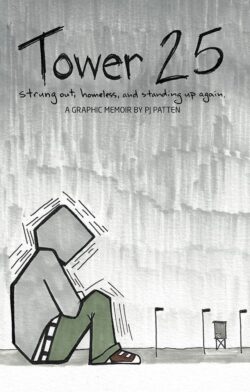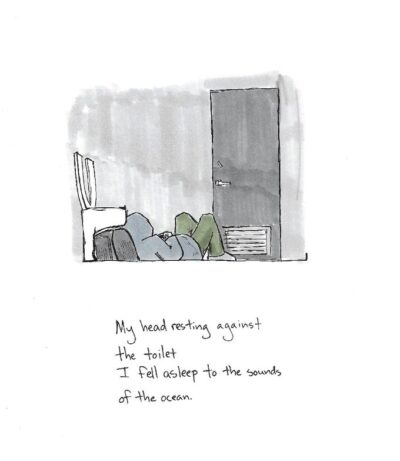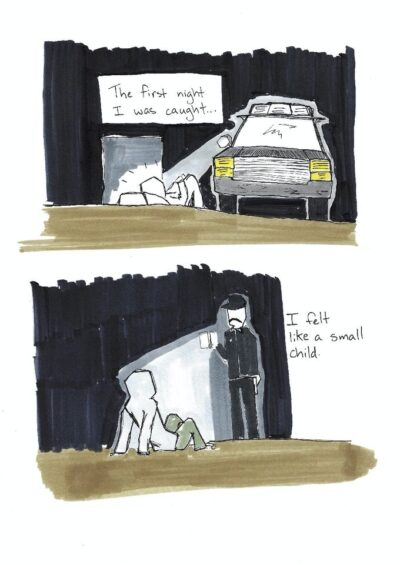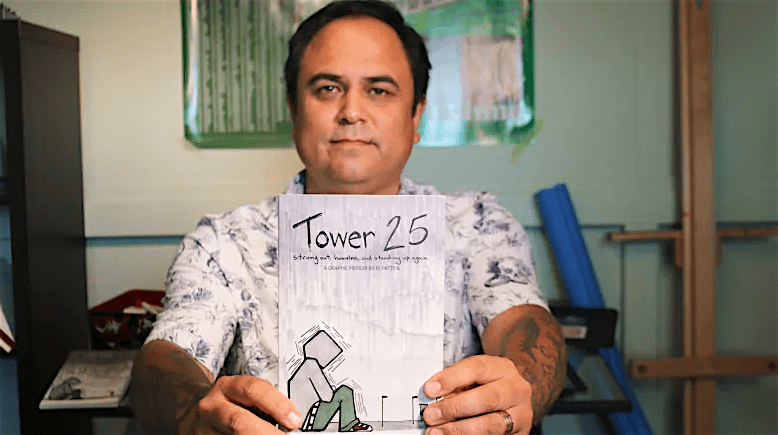1225 Stand up, take stock, get traction
Tower 25: Strung out, homeless, and standing up again; a graphic memoir
by PJ Patten
Vancouver: Cloudscape Comics Society, 2020
$20.00 / 9781927742174
Reviewed by Phyllis Reeve
*


How does an artist draw a shiver? Behold the cover of PJ Patten’s first graphic novel. The central figure is almost all sharp edges, except for the toe of a shoe. It’s raining. He looks fragile. His shivering is conveyed by more sharp lines, like darts or pins. Despite the sharpness we want to comfort him. He is cold; he is sick; he is in addiction withdrawal. Or all these at once.
The structure on stilts in the distance is Tower 25: not the acclaimed high rise in Nicosia, Cyprus, designed by Jean Nouvel, but a lifeguard tower at Huntingdon Beach, California. It is closed. There is no lifeguard to save PJ, but also no one to disturb him while he sleeps on the floor of a nearby public toilet. On the edge of Bolsa Chica State Park, the surfing haven presents itself as a convenient site for suicide.
But PJ Patten does not drown. He assures us in an afterword: “Being homeless, the backdrop for this story, was over fifteen years ago. Since then I spent ten years living at a Buddhist retreat center, left California, moved to the mountains of British Columbia, fell in love and settled in the city of New Westminster, B.C.” The author’s bio identifies him as a “poet, author, and illustrator.” Online references indicate increasing interest from other writers hoping to engage him as collaborator. His graphic designs include intriguing original tattoos and emblems for t-shirts. The book is the work of an artist.
 He holds close the Haiga art practice of his Japanese grandparents, opening his story with a quotation from the Buddhist philosopher Shantideva: “Suffering also has its worth.” The stillness of his shivering figure has a Zen quality about it, and his drawings suggest Haiga art without the accompanying Haiku poem. The text is prosaic, a running commentary which the reader may consult or ignore while immersing in the images.
He holds close the Haiga art practice of his Japanese grandparents, opening his story with a quotation from the Buddhist philosopher Shantideva: “Suffering also has its worth.” The stillness of his shivering figure has a Zen quality about it, and his drawings suggest Haiga art without the accompanying Haiku poem. The text is prosaic, a running commentary which the reader may consult or ignore while immersing in the images.
At the beginning of the book, PJ has a home, but he is already in such a condition that when he is evicted he makes no effort to find another. Chronology is uncertain, except that he is groping his way though his teens. His parents divorce when he is thirteen, but while “his life changed dramatically” at that point, this is not the source of his despair: “I had been burying things my whole life. It turned out there was a lot inside I had forgotten about.” We hear no more about his biological father. His mother remarries, and her “new husband” becomes “stepdad” and then “my dad,” whose misdirected trust and tough love inadvertently allow PJ to fall “over the edge into the Juvenile Justice system.” Arrested, the boy turns down the offered phone call, not because he resents his parents but because he doesn’t know what to say to them.
 So he falls to the bottom of life’s trash can, relying on drugs, mostly meth, petty thievery and unauthorised sleeping places. He gets sick. But even in the depths of aloneness, PJ is not a victim. The little figure quivering by Tower 25 recognises, but for a long time rejects, such concepts as responsibility and choice.
So he falls to the bottom of life’s trash can, relying on drugs, mostly meth, petty thievery and unauthorised sleeping places. He gets sick. But even in the depths of aloneness, PJ is not a victim. The little figure quivering by Tower 25 recognises, but for a long time rejects, such concepts as responsibility and choice.
Family remains at the far end of the telephone line he leaves dangling in the payphone booth as he walks back to his toilet shelter. He has a few friends: some who offer him places to live which he refuses because he doesn’t trust himself with an address from which he can contact dealers; one who warns him “not to get too used to being homeless,” another who supplies him with a new bar of soap and a new razor when PJ takes hold of himself. He spends his final dollar to use a computer and find a job.
While he waits for his place to become available, he is again arrested for sleeping rough and given a court date which will cause him to miss his scheduled job. But the text across a dramatic white/ black full page image proclaims “This is all on you. Not the police. Not society. Not your parents. Just you.” He throws away the court ticket and begins the rest of his life.

Such a wordy paraphrase does disservice to Tower 25, but it’s the best a non-artist reviewer can do for a book that is more show than tell. PJ Patten bends the rules of graphic novels to suit his purposes. Predominant black, white and grey images are washed with touches of green, blue and yellow. The drawings are kept faceless “with the hope that people would see themselves, someone they knew, or strangers on the street in these pages.” They are full of loneliness and pain, but not anger. “Comic books” often shout; this one doesn’t.
An icon which I knew I should know, but could not remember why, is that of the resilient little Daruma doll, who when tilted over always swings back into an upright position, illustrating the Japanese adage “seven times down, eight times up.” On the eighth stand, the Daruma opens its eyes and stays firm: “It was time to stand up and start anew.”
But it is not such mottoes which may grab the attention of someone who needs this book; it is the tender, empathetic drawings, which will also help the rest of us understand why homeless youth so obstinately refuse to return to the homes we suspect they have somewhere.
*

Phyllis Parham Reeve writes about local and personal history in her three solo books and in contributions to journals and multi-author publications. She is a contributing editor of the Dorchester Review and her writing appears occasionally in Amphora, the journal of the Alcuin Society. She co-founded the bookstore at Page’s Resort & Marina on Gabriola Island. More details than necessary may be found on her website. Editor’s note: Phyllis Reeve has also reviewed books by Marion McKinnon Crook, Daphne Marlatt, Ayesha Chaudhry, Sylvia Olsen, P.K. Page, Peggy Lynn Kelly & Carole Gerson, Iain Lawrence, Michael Kluckner, Jack Lohman, and Mona Fertig, among others.
*
The Ormsby Review. More Books. More Reviews. More Often.
Publisher and Editor: Richard Mackie
The Ormsby Review is a journal service for in-depth coverage of B.C. books and authors. The Advisory Board consists of Jean Barman, Wade Davis, Robin Fisher, Cole Harris, Hugh Johnston, Kathy Mezei, Patricia Roy, Maria Tippett, and Graeme Wynn. Scholarly Patron: SFU Graduate Liberal Studies. Honorary Patron: Yosef Wosk. Provincial Government Patron since September 2018: Creative BC
“Only connect.” – E.M. Forster

3 comments on “1225 Stand up, take stock, get traction”